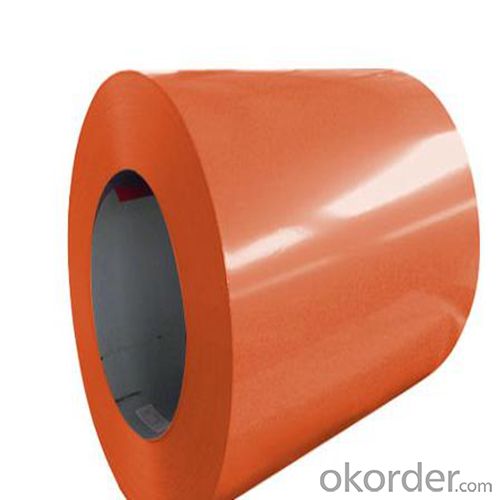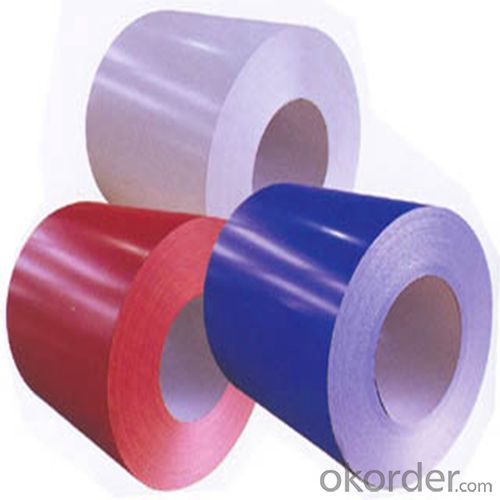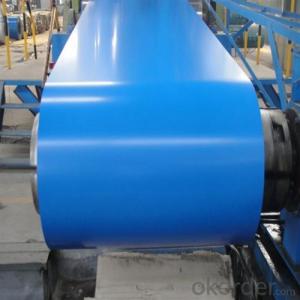Prepainted Ganvanized Steel DX51D of Thick PPGI
- Loading Port:
- Tianjin
- Payment Terms:
- TT OR LC
- Min Order Qty:
- 100 m.t.
- Supply Capability:
- 10000 m.t./month
OKorder Service Pledge
OKorder Financial Service
You Might Also Like
1. Defination of Prepainted Galvanized Steel Coil
Pre-painted coils are produced by coating a layer of paint on the surface of cold rolled, galvanized or galvalumed coils. Aesthetic appeal and durability are the key festures of color coated steel coil. A wide selection of colors is available to the customer and paints designed to meet specific end use could be specified.
2. Applications of Prepainted Galvanized SteelCoil
1) Buildings and constructions: roofing, ceilings, gutters, venting lines, indoor decorations, window frames, etc.
2) Electrical appliances: computer shells, washing machines, refrigerators, dehumidifiers, video recorders, water heaters, etc.
3) Agricultural equipments: troughs, feeding tools, agricultural driers, irrigation channels, etc.
4) Vehicle parts: back-seat plates of buses and trucks, conveying systems, oil tanks, etc.
3. Specifications of Prepainted Galvanized SteelCoil
Standard: ASTM;ASTM;JIS;GB
Grade: SGCC;(DX51D)
Thickness: 0.12-1.2mm
Width: 750-1250mm
Length: Coil or customer's requirements
Zinc Coating: 60-140g/m2
Painting : Top side from 15-25um; Bottom side from 5-10 um
Color : RAL numbers or customers' sample color
Application: building trade, electric apparatus, furniture and transport service
Production arts and crafts : Double coated double drying
Coil ID: 508mm
Coil Weight: 3-6 Ton
Type :coil
Packaging Detail: Fully seaworthy export packing with paper tube or as per customer's requirements
4. Prepainted Galvanized Steel Coil Images


5. Advantages of Our Prepainted Galvanized SteelCoil
1) Excellent corrosion resistance: The zinc layer provides a good protection of Pre-painted Galvanizeed Steel Sheet.
2) High heat resistance: The reflective surface of the material aids in efficiently reflecting the sunlight away and in turn reducing the amount of heat transmitted. The thermal reflectivity converts into energy savings.
3) Aesthetics: Pre-Painted Galvanized steel sheet is available in plethora of patterns and multiple sizes as per the requirements that given by our customers.
4) Versatility: can be used in the various areas.
6. FAQ
1) How about your company?
A world class manufacturer & supplier of castings forging in carbon steel and alloy steel,is one of the large-scale professional investment casting production bases in China,consisting of both casting foundry forging and machining factory. Annually more than 8000 tons Precision casting and forging parts are exported to markets in Europe,America and Japan. OEM casting and forging service available according to customer’s requirements.
2) How to guarantee the quality of the products?
We have established the international advanced quality management system,every link from raw material to final product we have strict quality test;We resolutely put an end to unqualified products flowing into the market. At the same time, we will provide necessary follow-up service assurance.
3) How long can we receive the product after purchase?
In the purchase of product within three working days, We will arrange the factory delivery as soon as possible. The pecific time of receiving is related to the state and position of customers.Commonly 7 to 10 working days can be served.
- Q:Where can I find a great deal online for Danesco Stainless Steel Egg Poacher
- Cheapest place to buy Danesco Stainless Steel Egg Poacher is amazon, and the price is $34.99. For more information check the link below....
- Q:PLS tell me all Foam Steel Characteristics and use?Thanks
- Foam steel [often steel foam] is used in applications that require light weight but high rigidity and strength. Watertight doors on modern ships are often made of foam steel. Pressure doors on aircraft are possible uses. As we keep striving for lighter weights in cars, foam steel might have some useful applications in bodies. There is a technical paper online that is in .pdf format that has a good discussion of the process and characteristics of foam steel.
- Q:How are steel coils inspected for surface defects using non-destructive testing methods?
- Steel coils are inspected for surface defects using non-destructive testing (NDT) methods to ensure their quality and integrity. There are several common NDT methods employed in this process. One of the most widely used methods is visual inspection, where trained inspectors visually examine the surface of the steel coils for any visible defects such as scratches, cracks, pits, or corrosion. This method is relatively simple and cost-effective but is limited to detecting only surface-level defects. Another commonly used NDT method is magnetic particle testing (MT). This method utilizes the principles of magnetism to identify surface and near-surface defects in ferromagnetic materials like steel. A magnetic field is applied to the steel coil, and iron particles are applied to the surface. If there is a defect, such as a crack or discontinuity, the iron particles will concentrate around it, making the defect visible to the inspector. Liquid penetrant testing (PT) is another NDT method used to inspect steel coils for surface defects. In this method, a liquid penetrant is applied to the surface of the coil. The penetrant is drawn into any surface defects by capillary action. After a certain period, excess penetrant is removed, and a developer is applied. The developer draws out the penetrant from any defects, making them visible to the inspector. Ultrasonic testing (UT) is a widely used NDT method that can detect both surface and subsurface defects in steel coils. High-frequency sound waves are transmitted into the steel coil, and the reflected waves are analyzed to identify any abnormalities. This method can detect defects such as cracks, inclusions, and voids that may not be visible to the naked eye. Additionally, eddy current testing (ECT) is another NDT method used for inspecting steel coils. This method utilizes electromagnetic induction to detect surface and near-surface defects. A coil carrying an alternating current is placed near the surface of the coil being inspected. Any changes in the coil's electrical conductivity caused by surface defects are detected and analyzed, allowing the inspector to identify and evaluate the severity of the defects. In conclusion, steel coils are inspected for surface defects using various non-destructive testing methods such as visual inspection, magnetic particle testing, liquid penetrant testing, ultrasonic testing, and eddy current testing. These methods ensure the quality and integrity of the steel coils before they are used in various applications.
- Q:What are the different types of packaging for steel coils?
- Steel coils can be packaged in various ways to meet the specific needs and preferences of manufacturers and distributors. Here are some commonly used packaging options: 1. Wooden Crates: To ensure safe transportation and handling, steel coils can be packed in robust wooden crates. These crates, made of durable wood materials like plywood or solid wood, provide excellent protection by securely holding the coils in place. 2. Steel Frames: Another option is to use steel frames, constructed with sturdy steel materials, to firmly secure the coils and prevent any movement or shifting. Steel frames are especially suitable for larger or heavier coils as they offer enhanced stability and durability. 3. Cardboard Boxes: For smaller or lighter steel coils, cardboard boxes can be a suitable choice. These boxes, made of strong and durable cardboard, provide adequate protection against minor impacts and scratches. They are also easy to handle and can be conveniently stacked or stored. 4. Plastic Wrapping: In addition to crates, frames, or boxes, steel coils can be wrapped in plastic materials for added protection. Plastic wrapping safeguards the coils from moisture, dust, and external elements during transportation and storage. This packaging option is commonly used in combination with other methods. 5. Transportation Racks: Specially designed transportation racks made of steel or other robust materials can be used for efficient handling and transport of steel coils. These racks securely hold the coils, allowing for easy loading and unloading, and ensuring enhanced safety during transit. Overall, the choice of packaging for steel coils depends on factors such as size, weight, transportation method, and desired level of protection. Manufacturers and distributors carefully consider these factors to select the most appropriate packaging solution that ensures the safe and efficient handling of steel coils throughout the supply chain.
- Q:How are steel coils used in the manufacturing of fuel systems?
- Steel coils are commonly used in the manufacturing of fuel systems for their strength, durability, and resistance to heat and corrosion. These coils are typically formed into various components such as fuel tanks, pipelines, and fuel lines. The steel coils provide structural support and ensure the integrity of the fuel system, enabling safe and efficient transportation, storage, and delivery of fuel.
- Q:What are the different types of steel coil cutting processes?
- Various industries utilize several different steel coil cutting processes. These processes include: 1. Shearing: The most widely used and simplest method of steel coil cutting involves utilizing a shear blade to cut the coil material into desired lengths. This can be done either manually or with the assistance of automated machinery. 2. Slitting: A process designed to cut wide coils into narrower strips, slitting involves passing the coil material through a set of circular knives that cut the steel into smaller coils or strips of the desired width. 3. Laser cutting: Renowned for its precision and efficiency, laser cutting involves using a high-powered laser to melt or vaporize the material along a predetermined path. This method is commonly employed for intricate designs or when high accuracy is required. 4. Plasma cutting: Another method of cutting steel coil involves using a plasma torch that generates a high-velocity jet of ionized gas to melt the material. Plasma cutting is known for its speed and ability to cut through thick materials. 5. Waterjet cutting: This process utilizes a high-pressure stream of water mixed with abrasive particles to cut through steel coil. Waterjet cutting is frequently chosen when the material being cut is sensitive to heat or when precision is necessary. 6. Saw cutting: A traditional cutting method, saw cutting involves using a saw blade with teeth to cut through the material. It is particularly effective for thicker materials and can be performed manually or with the aid of automated machinery. These represent just a few of the many steel coil cutting processes commonly employed. The choice of cutting method relies on several factors such as the material's type and thickness, desired accuracy, speed, and cost-effectiveness.
- Q:What are the key properties of steel coils?
- The key properties of steel coils include high tensile strength, excellent durability, corrosion resistance, and the ability to be shaped and formed into different products.
- Q:My musical saw has, despite my best efforts, got little patches of rust on it. How Do I go about removing the rust without spending too much on rust-removal products and without affecting the properties of the steel?
- I would suggest rust removal by electrolysis. Search youtube for that. It probably will not affect the metal but there are no guarantees. I would run a test on another metal. Also this process can be dangerous because hydrogen gas is a by-product - remember not to smoke or be cooking nearby! The Easy way is with BlackStar Rust Remover. It will turn the metal black and convert the rust to metal which can then be painted or left black.
- Q:What is the role of steel coils in HVAC systems?
- Steel coils play a crucial role in HVAC (heating, ventilation, and air conditioning) systems as they are responsible for facilitating the transfer of heat between the air and the refrigerant. In HVAC systems, steel coils are typically used in two main components: the condenser coil and the evaporator coil. The condenser coil is located in the outdoor unit of an HVAC system and its primary function is to release the heat from the refrigerant into the surrounding air. This coil is made up of multiple steel tubes that are bent into a serpentine shape and are attached to aluminum fins. As the hot refrigerant flows through these tubes, the steel coils ensure maximum surface area contact with the surrounding air, allowing for efficient heat transfer. Through this process, the heat is dissipated into the outdoor environment, resulting in the cooling of the refrigerant. On the other hand, the evaporator coil is situated in the indoor unit of the HVAC system and its role is to absorb heat from the air inside the building. Similar to the condenser coil, the evaporator coil consists of steel tubes that are connected to aluminum fins. The refrigerant, in a cold state, flows through these tubes, and as warm air from the building passes over the coils, the heat is transferred from the air to the refrigerant. This heat absorption process cools down the air, which is then circulated back into the building, providing the desired cooling effect. Overall, steel coils in HVAC systems are essential for heat transfer between the air and the refrigerant. Their design and placement allow for efficient cooling or heating of the air, depending on the system's mode of operation. Without steel coils, HVAC systems would not be able to effectively regulate the temperature and provide the desired comfort levels in residential, commercial, and industrial buildings.
- Q:What are the different packaging options for steel coils?
- There are several packaging options for steel coils, including wooden crates, steel frames, and metal or plastic bands. These packaging options help to protect the coils during transportation and storage, ensuring their integrity and preventing damage.
1. Manufacturer Overview |
|
|---|---|
| Location | |
| Year Established | |
| Annual Output Value | |
| Main Markets | |
| Company Certifications | |
2. Manufacturer Certificates |
|
|---|---|
| a) Certification Name | |
| Range | |
| Reference | |
| Validity Period | |
3. Manufacturer Capability |
|
|---|---|
| a)Trade Capacity | |
| Nearest Port | |
| Export Percentage | |
| No.of Employees in Trade Department | |
| Language Spoken: | |
| b)Factory Information | |
| Factory Size: | |
| No. of Production Lines | |
| Contract Manufacturing | |
| Product Price Range | |
Send your message to us
Prepainted Ganvanized Steel DX51D of Thick PPGI
- Loading Port:
- Tianjin
- Payment Terms:
- TT OR LC
- Min Order Qty:
- 100 m.t.
- Supply Capability:
- 10000 m.t./month
OKorder Service Pledge
OKorder Financial Service
Similar products
New products
Hot products
Related keywords




























